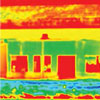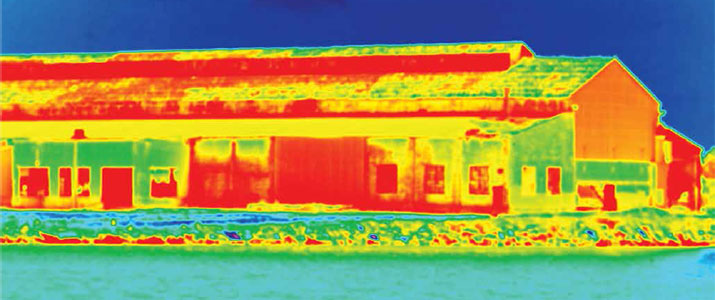
The Heat Is On
For buyers and sellers, thermal sensors see beyond night vision
- By Christopher Lindenau
- Jul 01, 2013
 As police surrounded the suspected Boston bomber hiding inside a
boat stored behind a Watertown, Mass., home last April, officers
with a thermal camera peered through the hull and tarp to watch
his every move. Unlike night vision goggles that detect visible light
energy, thermal imaging cameras see differences in surface temperature.
Thermal imaging “cameras” are more accurately called sensors.
As police surrounded the suspected Boston bomber hiding inside a
boat stored behind a Watertown, Mass., home last April, officers
with a thermal camera peered through the hull and tarp to watch
his every move. Unlike night vision goggles that detect visible light
energy, thermal imaging cameras see differences in surface temperature.
Thermal imaging “cameras” are more accurately called sensors.
The components include a display, detector, signal processing and optics. These
cameras operate by sensing infrared energy emitted from a target—the alleged
Boston bomber—and the target’s surroundings. The landscape seen through a
thermal camera is a collage of black-and-white images, with the ones giving off
the most heat seen as white.
Many in the security industry think of thermal cameras as something only useful
to special operations forces, firefighters and police. Many believe the cost of
this equipment is out of reach for practical applications. In fact, only 0.1 percent
of the commercial security market uses thermal imaging cameras today.
Prices Drop
However, over the past few years, as the wars in Iraq and Afghanistan have wound
down, post-war manufacturing capacity has exceeded military market demand,
which has caused the price of thermal imaging systems to drop. For example,
SP&T News reported that the volume of chips made for these cameras is causing
prices for standard resolution (640x480) thermal imaging cores with fixed lenses to
drop from $15,000 per unit to four figures. And, at ISC West 2013, some vendors
announced models for around $3,000.
However, when people see stories of thermal imaging as an aid to capturing fugitives
or as part of a commando raid, it reinforces the notion that the technology
is beyond the need of commercial security. Practically speaking, that sentiment is
wrong. Commercial security can benefit from not only adopting thermal imaging
but integrating it into an existing network surveillance system for use with enterprise
video management software.
Imagine a warehouse that uses floodlights, HD visible cameras, PIR (motion)
sensors and ground loops along its perimeter to detect intruders at night. Perhaps
the warehouse owners employ security personnel to monitor these physical security
measures for intrusion, but these stop-gap measures are prone to produce
false alarms and have limited efficacy for night detection. Visible cameras can’t
spot trouble lurking under groundcover or beyond shadows. Motion detectors are
limited by range and obstacles in the path of detection, and ground loops are difficult
to install and can fail.
Complementing Visible Inspection and Cameras
In terms of cost versus efficacy, there is no comparable alternative to thermal imaging
for detection. At night, the next best alternative is not even close. Whole
fence lines, wide field areas, areas with architectural or foliage obstructions can
use thermal surveillance for intrusion detection. Thermal imaging offers a level of detection that complements visible inspection qualities and HD visible cameras during the day to provide
an overall better picture of a facility, a real value to
security personnel who cannot be everywhere at once.
In the commercial sector, power generation plants,
airport fence lines and data centers are using thermal
imaging to spot intruders. Due to the limitations of visible
camera technology, and labor and wiring costs to
install individual cameras—many customers are now
looking for cameras that employ both visible and thermal
cameras in the same system—a dual imaging approach.
In recent physical security upgrades at a major
metropolitan airport outside of New York City, dual
imaging was preferred over any other measure to detect
perimeter intrusion. When used with software analytics,
the result is both potent and cost effective.
The U.S. military first used thermal imaging cameras
for operations in the late 1960s. Like anything
the military procures, suppliers must meet exacting
standards. For example, thermal imaging systems for
military use must meet specifications for temperature
(from -58°F to 165°F), vibration (i.e., HumVee Standard)
and surge protection (i.e., Mil-STD-810G) beyond
what most commercial thermal imaging cameras
require. As commercial security professionals explore
a dual imaging approach, there will be increasing
pressure on commercial systems to meet militarygrade
standards because buyers will want to ensure
their investment lasts. There also will be pressure to
develop military-grade, network-ready thermal imaging
systems as the surveillance industry moves toward
the use of Ethernet switches and software, versus digital
recorders and hardware.
A Networked View of the World
Although analog camera systems still claim up to 80
percent of the industry’s installations, IP and networked
cameras are rapidly gaining ground. One
reason is the ease with which installers can add new
network cameras to an IP network. If, for example, an
integrator has to add more network cameras, then a
technician can run cable from the nearest switch. One
switch commonly supports up to 64 cameras, and can
be located within 100 meters of them, simultaneously
providing power through one cable.
By contrast, an analog camera installation may
require a technician to run video and power cables
from each new camera back to a digital video recorder
and a centrally-based power supply—a significant
increase in wire and installation cost.
With this advantage in mind, traditional IT-based
companies are increasingly entering the security industry
with new product offerings. such as software
video management platforms, powered PoE switches
and video recording solutions. This is driving corporate
IT departments to become part of the evaluation
process for the adoption of new products like
networked thermal imaging systems. Whereas with
analog systems the director of physical security chose
new surveillance technology on behalf of the company,
today network cameras systems empower the
CTO or IT director to be the key decision maker. And
that requires providers of security imaging systems to
show expertise in both optics and networking.
Adapting Thermal Imaging
to Fit Today’s Platform
Thermal imaging system suppliers must adapt their
technology to fit into an array of complex IT platforms,
and that concept is not always easy to grasp
for companies that specialize in developing camera
systems. Network camera makers have to ensure that
the software they sell with their cameras will integrate
with the network firewalls, software and hardware
that a corporate IT department has already put
in place. This is a different mindset. But, suppliers
adopting this point of view will help the customer
trying to coordinate a purchase between his security
department and IT group.
For example, modern enterprise software requires
standard protocols that enable a technician to integrate
a camera system with a network. The network
protocols are simply the mechanism by which systems,
servers and devices talk to one another. Common protocols
already exist for cameras, and these standards
are being adopted by thermal imaging systems, too.
One such protocol is ONVIF, which was created by
global industry group Open Network Video Interface
Forum. The standard aims to facilitate communication
between all physical IP-based security products.
The ONVIF protocol is already commercially available
on some network thermal cameras. Standard
protocols like ONVIF will allow manufacturers of
thermal cameras to integrate with the customer’s chosen
video management software.
Of course, analog thermal cameras also exist, and
integrators can encode these analog thermal imaging
systems to make them IP-ready, too. In fact, for the
majority of security appliances using analog technology,
most commercial encoders will accept an analog
thermal camera and create an IP format for it.
But let’s say a company has built its security system
on an analog footprint and wants to use a network
thermal camera. The integrator would recommend a
third-party encoder here, too. With the encoder, the
integrator can then migrate to an IP video stream.
The beauty of ONVIF lies in the fact that purchasing
an ONVIF-compliant encoder and integrating it
with an ONVIF-compliant camera provides interoperability.
In 2011, ONVIF developed a profile concept.
This profile simplifies the identification of interoperable
products, and it lets customers easily identify specific
features by profile.
“The primary benefit of our Profile concept is
knowing that when two products bear the Profile C
[access control] or G [video storage] mark, the same as
what is already available with Profile S [video streaming]
conformant products, they will work together,”
said Per Björkdahl, ONVIF chairman. “Rather than
trying to figure out whether one version of the ONVIF
specification is compatible with another, or which features of the product might interfere with interoperability,
seeing that mark ensures a successful interface.”
There is much to be excited about with network
appliances, especially thermal imaging systems. But
there is one major shortcoming. All of that compression
that is part of delivering a network image via
camera causes latency. The degree of latency may be a
matter of milliseconds, but it’s there. That said, there
are companies that have achieved a degree of latency
that is now less than 150 milliseconds. Companies
that know how to improve the compression algorithm
to decrease latency can overcome this shortcoming of
network appliances.
What’s Next for Commercial Security?
Today, thermal imaging systems are sold with a standard
resolution of 640x480, which makes 1,280x720p
the next likely thermal imaging system for commercial
applications. While these HD imaging systems are available,
they can cost upwards of $50,000 but expect to
see such imaging systems come down in price. Typically
you will see HD thermal imaging systems in the military,
aboard a tank for targeting enemy combatants.
The cost of these systems is in the production of
the lens, as well as the camera core, which processes
the image. While producing the core for an HD thermal
imaging camera can be expensive, the greater cost
is the lens. To see the transfer of infrared light emitted
from an object, lens manufacturers have to use a
significant refinement process. These lenses range in
price from fixed-lens configurations, with a fixed focal
plane, to continuous zoom lens. And the price point
jumps by a factor of four from fixed lenses to continuous
zoom lenses.
Whenever manufacturers increase the resolution
of the chip inside a camera, the price of the camera
core will increase by a factor of five. Consequently,
the increased size of the imager and the lens will also
mean a price increase by a factor of five.
Beyond 720p is 1080p. A 1080p thermal imaging
system for commercial use is still something we have
yet to see. The size of the imager alone would be large
and the lens would be comparable in diameter to a
basketball, making the system too big for commercial
applications.
With the advent of HD thermal technology for
commercial applications, imaging-system makers
will give customers a way to not only detect, but also
identify threats. The distinction is important, and it’s
based on the Johnson criteria. The Johnson criteria
give us a way to understand the performance of visual
devices, such as imaging systems. Simply put, criteria
defines “detection” as observing the presence of an
object; whereas “identification” is not only spotting a
car but also seeing that it’s a VW Bug.
Thermal imaging technology offers a level of detection
and identification that will
complement your existing surveillance
system when the heat is on.
This article originally appeared in the July 2013 issue of Security Today.